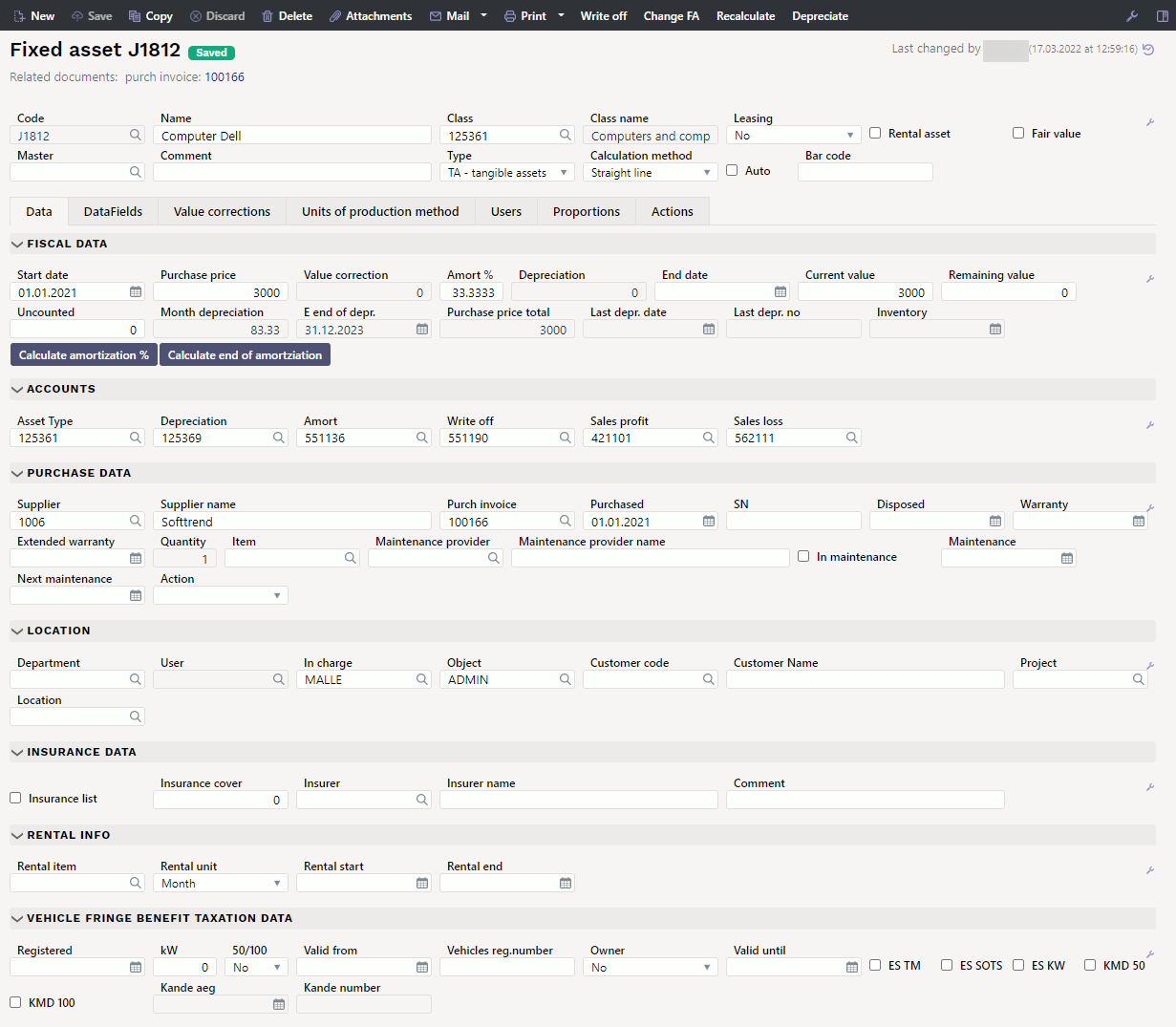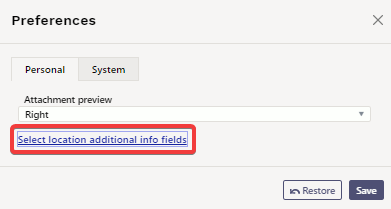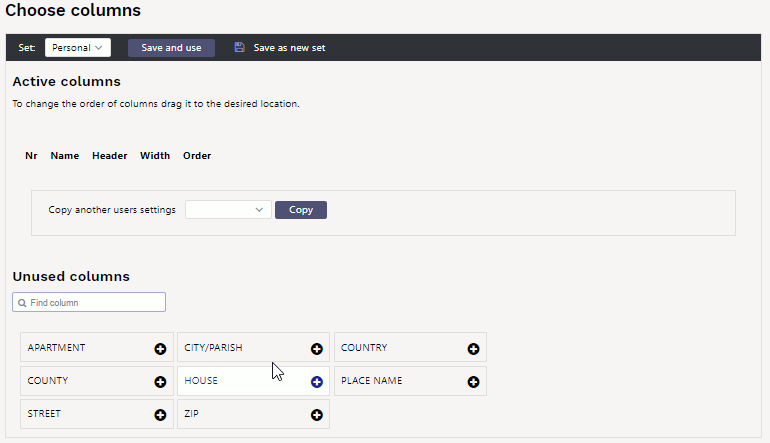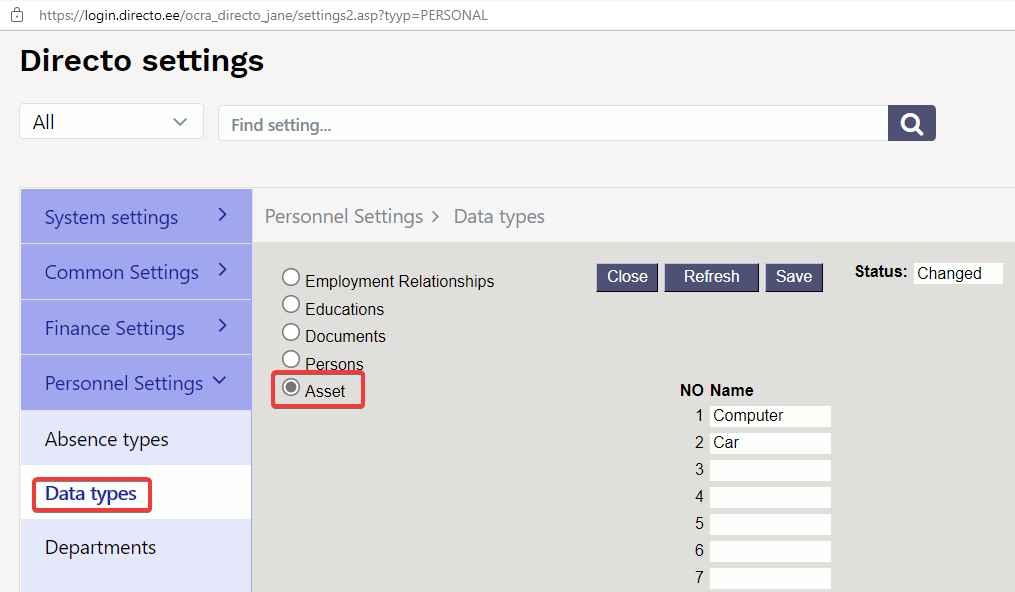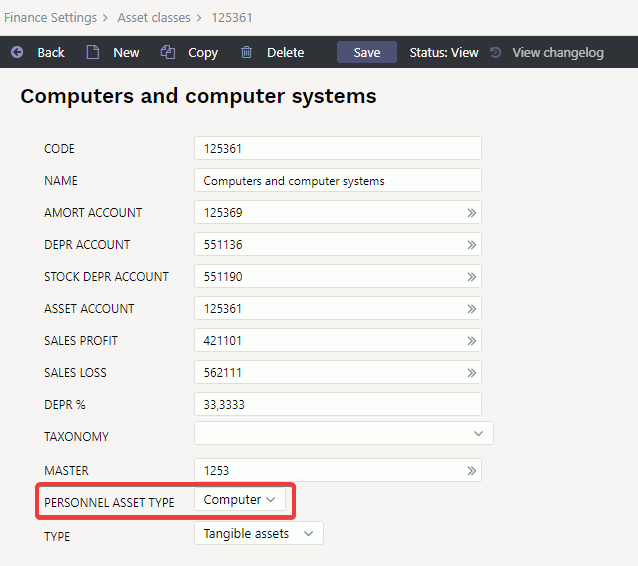This is an old revision of the document!
Table of Contents

Fixed assets
Settings
The following settings should be completed before creating fixed asset cards:
Fixed assets card
1. Document buttons
1.1. Header buttons
- New - opens a new blank document
- Save - saves the document
- Copy - makes a copy of the document. Only one unsaved draft can be opened at a time. Next copy can be made, when new document is saved.
- Discard - The button is active when the transaction is in draft status or unsaved changes have been made to the entry. After selecting Discard, the unsaved changes will be removed and the transaction will be saved.
- Delete - deletes the transaction. Asks in advance if you are sure you want to delete. Only these fixed assets documents can be deleted which have no operations performed (calculated depreciation, follow-up documents created etc).
- Attachments - allows to associate files with a document
- Mail - allows to send a document by e-mail
- Print - prints the document
- Write off - allows assets to be written off
- Change FA - allows to make changes to the fixed asset
- Recalculate - allows to add asset recalculations
- Depreciate - makes depreciation transactions
-
1.2. Row buttons
2. Document fields
2.1. Header fields
- Code: unique ID that can be entered manually or selected from double-click / right-click options
- Name: name of fixed asset
- Class: asset class code - places the financial accounts, depreciation % and type related to the asset class, groups them in the fixed asset reports. Selectable by double-clicking / right-clicking. Only classes with a fixed asset type can be saved.
- Class name: asset class name
- Leasing: options NO, Capital lease, Operating lease - information field for the acquisition of a fixed asset
- Rental asset: checkmark. Allows to select this fixed asset for lease contract. Opens the Rental Info section on the Asset card.
- Fair value: checkmark. Indicate if the fixed assets are recorded at fair value.
- Master: if the fixed asset is a part of another fixed asset, reports can be taken with the master asset.
- Comment: specifying field of the fixed asset name
- Type: tangible asset/intangible asset
- Calculation method: straight line, diminishing balance, units of production
- Auto: allows to select this asset for the calculation of the vehicle's fringe benefit. Opens Vehicle's fringe benefit taxation data on asset card.
- Bar code: asset bar code
2.2. Data
2.2.1. Fiscal data
- Start date: date from which the depreciation is calculated. Usually fixed asset purchase date. Related to the date of purchase. The start of the calculation can be in the same month in the past compared to the date of purchase. Future can be used.
- Purchase price: fixed asset original purchase price (the purchase price may also be negative)
- Value corrections: total cost of fixed assets additional amounts
- Amort: depreciation % per annum
- Depreciation: not required for new fixed assets. After the depreciation transaction has been made, depreciated amount is entered here automatically. To be filled in entering opening balances, changing the system settings if necessary “Asset date for opening balances”.
- End date: blank by default. The date of write-off shall be the date of write-off. Fill in if relevant and the depreciation calculation will be completed by a specific date. Pressing the “Calculate Amortization %” button will calculate the depreciation % so that the fixed asset will be depreciated by the date entered, if it is filled in.
- Current value: fills in automatically (purchase price - depreciation)
- Remaining value: the residual value of the fixed assets to which the fixed assets are depreciated
- Uncounted: if the asset has future amortization lines (not transactions), the sum of these rows is displayed here
- Month depreciation: informative field, one month's depreciation expense
- E end of depr.: informatiivne väli, arvutab arvestuse alguse aja ja amordi % järgi amortisatsiooni arvestamise lõpu aja lineaarse amortisatsioonimeetodi järgi. Ei ole aluseks amortisatsioonikannete tegemisel.
- Purchase price total: adds up the purchase price and value corrections
- Last depr. date: date of the last depreciation calculation
- Last depr. no: the number of the last depreciation transaction as a link
- Inventory: date of inventory
- Calculate end of amortization: calculates the end date of depreciation
2.2.2. Accounts
If asset classes are filled in, accounts are placed from classes.
- Asset type: an asset account with the acquisition cost of fixed assets
- Depreciation: asset account, for example, “Depreciation of accumulated fixed assets“
- Amort: expense account, for example, “Depreciation of fixed assets“
- Write off: expense account used for the write-off
- Sales profit: income account, in which both sales revenue and written-off residual value are entered in the sale of fixed assets, if the selling price is higher than the residual value
- Sales loss: income account, in which both sales revenue and written-off residual value are entered in the sale of fixed assets, if the selling price is lower than the residual value

2.2.3. Purchase data
- Supplier: supplier code on purchase invoice
- Supplier name: supplier name on purchase invoice
- Purchase invoice: the purchase invoice number from which the fixed asset card was created. The link opens the purchase invoice.
- Purchased: purchase invoice date
- SN: serial number - information field
- Disposed: date
- Warranty: date
- Extended warranty: date
- Quantity: if fixed asset is created from purchase invoice the quantity information is taken from the purchase invoice. Fixed asset quantity is 1.
- Item: item code
- Maintenance provider: maintenance provider code
- Maintenance provider name: name of the maintenance provider
- In maintenance: checkmark
- Maintenance: date (last maintenance / repair)
- Next maintenance: date (next scheduled maintenance / repair)
- Action: selection of different activities- purchase, received free of charge, improvements, construction in progress in, property, unfinished developments, off-balance sheet asset in
2.2.4. Location
- Department: option of department tab
- User: option of the user tab, the code is placed
- In charge: option of the user tab, the code is placed
- Object: object or list of objects with commas
- Customer code: option of the customer tab, the code is placed
- Customer Name: name of the selected customer
- Project: option of the project tab
- Location: address ID. If a department is selected, only the location codes (address ID) marked on that department can be placed. If no department is marked, all location (address ID) codes can be selected.
2.2.5. Insurance data
- Insurance list: checkmark, selecting will create an insurance list
- Insurance cover: the amount in which the low value asset is insured
- Insurer: insurance supplier code
- Insurer name: insurance supplier name
- Comment: text field
2.2.6. Rental info
- Rental item:an article that is placed on a fixed asset contract as a line item or the article under which the fixed asset is leased. The field is filled by default when you place an article on a fixed asset on rental item field in item card On asset card this field can be replaced.
- Rental unit: options - month, day, without sunday, workday
- Rental start: determines the date when fixed asset is offered for rent. It can also be empty or only one of them can be empty.
- Rental end: determines the date fixed asset lease expires
2.2.7. Vehicle fringe benefit data
- Registered: note on the car registration card
- kW: car engine power kW
- 50/100: usage options no, 50, 100 according to Estonian tax law
- Valid from: beginning of the period from which the fringe benefit tax is calculated for the car
- Vehicles reg. number: car registration number
- Owner: options No, Employer or Personal
- * Valid until: the end of the period from which the calculation of car fringe benefit tax is terminated
- ES TM: checkmark, makes a fringe benefit income tax transaction
- ES SOTS: checkmark, makes a fringe benefit social tax transaction
- ES kW: checkmark, calculates the sum on which the car fringe benefit is based on
- KMD 50:checkmark, determines the number of cars in the 50% use in VAT declaration
- KMD 100: checkmark, determines the number of cars in the 100% use in VAT declaration
- Transaction time : indicates the fringe benefit tax calculation last date
- Transaction number : indicates the transaction number (transaction link opens in the Activities tab)

2.3. Data fields
Data fields can be used to add parameters that are not described on the Low Value Asset card and later use in reports. Data fields to be described Lisaväljad. LINK TULEB ÄRA MUUTA
- Type: selection of additional fields described on the fixed asset card
- Content: the contents of the data field selected in the selection line or added manually
- Parameter: text field
2.4. Value corrections
- Date: date - start of calculation
- Value correction: adding an amount
- Object: object or list of objects with commas
- User: option of the users tab, code is placed
- Comment: text field
- Supplier: option of the suppliers tab, code is placed
- Supplier name: selected supplier name
- Document: selection of the list (purchase invoice, expense, written off data, recalculation)
- Number: document number
- Purchased: date
- Action: selection of different activities- purchase, received free of charge, improvements, construction in progress in, property, unfinished developments, off-balance sheet assets in
2.5. Units of production method
- Date: date
- Usage: text field
2.6. Users
Type- asset type in Personnel module. Selection from the drop-down menu. Setup: Põhivara ja personali vahendite seos;
User- selection from users tab. Code is placed;
User name- user name is displayed (after saving), cannot be changed;
Start date- date of issue the fixed asset to the user;
End date- asset return date or termination of liability;
Comment- explanatory text. Not required;
Close out- selection from users tab. Code is placed;
Close out name- name is displayed (after saving), cannot be changed
Contract- the document on the basis of which the fixed asset was issued to the user. Text field. Not required;
If user is added to the fixed asset card through Users tab, then it is immediately in the Assets tab on personnel card:
7.2.1 Setup and usage options
Relation between assets and personnel assets
It is necessary to set the assets Types, in order to save assets lines to Assets tab in Employee card. A list of asset types is created Settings→Personnel settings→Data Types→Asset:
A list of asset groups is created to this table as we want to systematize them in the Personnel module. This list does not have to match to the asset classes list directly.

For Asset class is selected to, which personnel module asset type the given class corresponds to:

Setting: Asset has one active in charge user
Settings→System settings→Asset settings→Asset has one active in charge user:
specifies whether there can be multiple end-dated rows in the Users tab at one time or not. In other words, can there be multiple users at the same time. Setting options: yes, no:
Yes- When a new user is added to the table, the previous user's row is “closed” and its end date is automatically set to one day less than the new user's start date: adding a new user to the table, the previous user's row is “closed” and its end date is automatically set to one day less than the new user's start date:
Only the last line can be edited and deleted (previous users lines are locked). If you delete the last line, the previous one becomes the active line and can be changed. Also the end date is removed from it.
No- all lines are freely editable. Except for required fields that must be filled (Type, User, Start date). This means that the asset has multiple concurrent users and the asset is on a several employee card.
System setting: Asset and personnel relation
Option user and in charge is intended for use, when the system setting Asset has one active in charge user=Yes is selected.
Specifies which field (user or in charge) on the fixed assets tab is updated automatically, when a new user is added to the users tab (the field is locked and cannot be changed manually). This means that the selected field (user or in charge) always has the currently active user or in charge user.
Option No relation is intended for use, when the system setting Asset has one active in charge user=No is selected, then the fields User and In charge can be changed freely.
7.3. Reports
ON TÄIENDAMISEL !!
The reports Asset list and Asset history can be taken by a valid user or in charge user. It means the reports take into account the user / in charge user that are on the asset main page.
Therefore, it is reasonable to turn on the system settings Asset and Personnel Relation so that the Users tab active user is also a valid user or a in charge user on the main page.
8. Asset actions
Asset actions codes are created to monitor different fixed assets actions.
For example, in the case of a purchase, the default code is “purchase”, the code can be changed before the first depreciation calculation or follow-up documentation is made.
Actions can be used in reports.
Some activities appear on the asset card only through additional documents - Fixed Asset change, Low value Asset change, Fixed Asset recalculation, Asset write-off, Asset inventory.
9. Fixed Assets register
Register allows to sort fixed asset cards, etc.
Buttons
- Add new - opens new empty fixed asset card.
- Browse - entering the fixed asset code in the Open code box, opens the fixed asset card.
- Create depreciation transaction - calculates depreciation for all fixed asset cards at once.
- Update history - updates the fixed asset depreciation history - possible to check on the card whether the depreciation was calculated correctly (if wrongly, then it must be made to transaction, deleted it and correct it).
- Delete history - deletes fixed asset future periods depreciation transactions which are calculated using the “Asset History Preview feature” setting.
Buttons Update history and Delete history appear, when the asset system settings have been filled:
- Asset history preview feature - Yes
- How many months ahead the Asset history is generated - greater than 0.
If Update history is created with a future period date, then future period depreciation transactions are previewed on Asset history report, although no depreciation has been calculated.

10. Frequently Asked Questions
10.1. How do I get rid of a draft?
- If a draft is left from document, cannot be saved and reports an error, then the error message can be removed by closing the asset card, reopening it and pressing Discard.
- In the Fixed Assets and Low Value Assets browser can display column Draft with button Choose Columns and filter the assets by draft.
- If there is a draft from document that you do not want to save, press Discard


